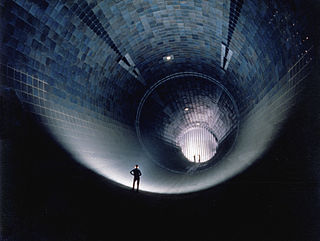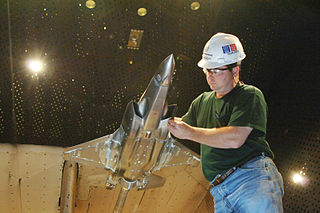
A jet engine is a type of reaction engine discharging a fast-moving jet that generates thrust by jet propulsion. This broad definition includes airbreathing jet engines. In general, jet engines are combustion engines.

A turboprop engine is a turbine engine that drives an aircraft propeller.

The turbojet is an airbreathing jet engine, typically used in aircraft. It consists of a gas turbine with a propelling nozzle. The gas turbine has an air inlet, a compressor, a combustion chamber, and a turbine. The compressed air from the compressor is heated by the fuel in the combustion chamber and then allowed to expand through the turbine. The turbine exhaust is then expanded in the propelling nozzle where it is accelerated to high speed to provide thrust. Two engineers, Frank Whittle in the United Kingdom and Hans von Ohain in Germany, developed the concept independently into practical engines during the late 1930s.

An air compressor is a device that converts power into potential energy stored in pressurized air. By one of several methods, an air compressor forces more and more air into a storage tank, increasing the pressure. When tank pressure reaches its engineered upper limit, the air compressor shuts off. The compressed air, then, is held in the tank until called into use. The energy contained in the compressed air can be used for a variety of applications, utilizing the kinetic energy of the air as it is released and the tank depressurizes. When tank pressure reaches its lower limit, the air compressor turns on again and re-pressurizes the tank. An air compressor must be differentiated from a pump because it works for any gas/air, while pumps work on a liquid.

A rocket engine uses stored rocket propellants as reaction mass for forming a high-speed propulsive jet of fluid, usually high-temperature gas. Rocket engines are reaction engines, producing thrust in accordance with Newton's third law. Most rocket engines use the combustion of reactive chemicals to supply the necessary energy, but non-combusting forms such as cold gas thrusters and nuclear thermal rockets also exist. Vehicles propelled by rocket engines are commonly called rockets. Rocket vehicles carry their own oxidizer, unlike most combustion engines, so rocket engines can be used in a vacuum to propel spacecraft and ballistic missiles.

The bypass ratio (BPR) of a turbofan engine is the ratio between the mass flow rate of the bypass stream to the mass flow rate entering the core. A 10:1 bypass ratio, for example, means that 10 kg of air passes through the bypass duct for every 1 kg of air passing through the core.
Forced induction is the process of delivering compressed air to the intake of an internal combustion engine. A forced induction engine uses a gas compressor to increase the pressure, temperature and density of the air. An engine without forced induction is considered a naturally aspirated engine.

SABRE is a concept under development by Reaction Engines Limited for a hypersonic precooled hybrid air-breathing rocket engine. The engine is being designed to achieve single-stage-to-orbit capability, propelling the proposed Skylon spaceplane to low Earth orbit. SABRE is an evolution of Alan Bond's series of liquid air cycle engine (LACE) and LACE-like designs that started in the early/mid-1980s for the HOTOL project.

The Pratt & Whitney J58 was a jet engine that powered the Lockheed A-12, and subsequently the YF-12 and the SR-71 aircraft. It was an afterburning turbojet with a unique compressor bleed to the afterburner which gave increased thrust at high speeds. Because of the wide speed range of the aircraft the engine needed two modes of operation to take it from stationary on the ground to 2,000 mph (3,200 km/h) at altitude. It was a conventional afterburning turbojet for take-off and acceleration to Mach 2 and then used permanent compressor bleed to the afterburner above Mach 2. The way the engine worked at cruise led it to be described as "acting like a turboramjet". It has also been described as a turboramjet based on incorrect statements describing the turbomachinery as being completely bypassed.

A heater core is a radiator-like device used in heating the cabin of a vehicle. Hot coolant from the vehicle's engine is passed through a winding tube of the core, a heat exchanger between coolant and cabin air. Fins attached to the core tubes serve to increase surface for heat transfer to air that is forced past them, by a fan, thereby heating the passenger compartment.
The National Gas Turbine Establishment in Fleet, part of the Royal Aircraft Establishment (RAE), was the prime site in the UK for design and development of gas turbine and jet engines. It was created by merging the design teams of Frank Whittle's Power Jets and the RAE turbine development team run by Hayne Constant. NGTE spent most of its lifetime as a testing and development centre, both for experimental developments and to support commercial engine companies.
The University of Texas at Arlington Aerodynamics Research Center (ARC) is a facility located in the southeast portion of the campus operated under the Department of Mechanical and Aerospace Engineering. It was established in 1986 as part of an expansion of UTA's College of Engineering. The ARC contributes to the vision of UTA and the University of Texas System to transform the university into a full-fledged research institution. It showcases the aerodynamics research activities at UTA and, in its history, has established itself as a unique facility at a university level. The wind tunnels and equipment in the facility were mainly built by scouting for and upgrading decommissioned equipment from the government and industry. Currently, Masters and Ph.D. students perform research in the fields of high-speed gas dynamics, propulsion, and Computational fluid dynamics among other projects related to aerodynamics.
An airbreathing jet engine is a jet engine propelled by a jet of hot exhaust gases formed from air that is forced into the engine by several stages of centrifugal, axial or ram compression, which is then heated and expanded through a nozzle. They are typically gas turbine engines. The majority of the mass flow through an airbreathing jet engine is provided by air taken from outside of the engine and heated internally, using energy stored in the form of fuel.

The High-Enthalpy Arc-Heated Facilities at Arnold Engineering Development Complex provide aerothermal ground test simulations of hypersonic flight over a wide range of velocities and pressure altitudes in support of materials and structures development. The facility is composed of three Arc Heaters: HEAT-H1, HEAT-H2, and Heat-H3 which can heat air up to 13,000 degrees Rankine through a controlled high voltage direct current electric arc discharge. The test unit is owned by the United States Air Force and operated by National Aerospace Solutions.
The von Karman Gas Dynamics Facility at Arnold Engineering Development Complex, Arnold Air Force Base, Tennessee, provide aerothermal ground test simulations of hypersonic flight over a wide range of velocities and pressure altitudes. The facility consists of three Hypersonic wind tunnels: Tunnel A, B, and C. The wind tunnels can be run for several hours at a time thanks to a 92,500 horsepower air compressor plant system. The test unit is owned by the United States Air Force and operated by National Aerospace Solutions.

The Propulsion Wind Tunnel Facility, located at Arnold Engineering Development Complex, Arnold Air Force Base, Tennessee, holds three wind tunnels: the 16-foot transonic (16T), 16-foot supersonic (16S), and the aerodynamic 4-foot transonic (4T) tunnels. The facility is devoted to aerodynamic and propulsion integration testing of large-scale aircraft models. The tunnels are powered by a large compressor plant which allows the wind tunnels to run for extended periods of time. The test unit is owned by the United States Air Force and operated by Aerospace Testing Alliance.
The AEDC Sea Level Test Cells, located at Arnold Engineering Development Complex, is a collection of test cells used to economically perform durability testing on large augmented turbine engines at near sea level conditions. All test units in the facility are owned by the United States Air Force and currently operated by National Aerospace Solutions.
Space Engine Systems Inc. (SES) is a Canadian aerospace company led by Pradeep Dass and is located in Edmonton, Alberta, Canada. The main focus of the company is the development of a light multi-fuel propulsion system to power a reusable single-stage-to-orbit (SSTO) and hypersonic cruise vehicle. Pumps, compressors, gear boxes, and other related technologies being developed are integrated into SES's major R&D projects. SES is collaborating with the University of Calgary to study and develop technologies in key technical areas of nanotechnology and high-speed aerodynamics.

A turbine-electric transmission system includes a turboshaft gas turbine connected to an electrical generator, creating electricity that powers electric traction motors. No clutch is required.













